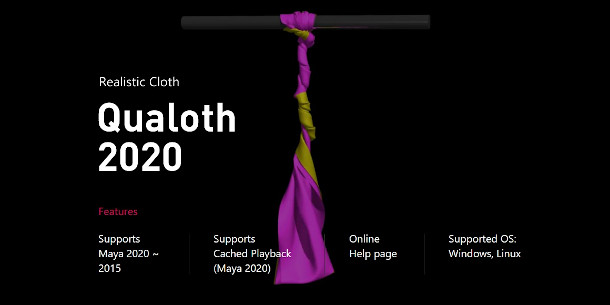FXGear ships Qualoth 2020

Korean physics tools developer FXGear has released Qualoth 2020, the latest version of its Maya cloth-simulation plugin, adding support for Maya 2020’s cached playback system for simulations.
Other changes in the update, which is Qualoth 4.7 in conventional numbering, make it possible for users to achieve finer control over cloth self-collision and simulation damping.
A robust cloth simulation tool for large VFX and animation projects
Although hasn’t had a lot of media coverage recently, Qualoth has been around for over a decade.
It’s a robust cloth simulation tool, designed for large-scale VFX and feature animation projects: users have included DreamWorks, Mr. X, Square Enix and many big Asian production facilities.
Unlike many cloth tools, the simulation model it users is not based on spring networks or particle systems, which FXGear says results in more accurate cloth motion, particularly wrinkling.
As well as accepting conventional polygonal meshes as source geometry – it supports tri, quad and non-manifold meshes – Qualoth works with panel-based clothing created in tools like Marvelous Designer.
Users can control simulations by adjusting material properties like stretch, shear and bending resistance, or global parameters like damping, friction and drag.
It is also possible to add goal constraints to a cloth object to art-direct a simulation.
Other key features include bidirectional interaction with Maya Fluid Effects for wind animation, and support for partial resimulation, making it possible to iterate on a sim by resimulating only selected vertices.

New in Qualoth 2020: support for Maya 2020’s cached playback system
To that, Qualoth 2020 adds support for Maya 2020, including its extended cached playback system.
That should make it possible to scrub through Qualoth cloth simulations smoothly in the viewport, in the same way as those generated by Maya’s native simulation tools.
Other changes include the option to set an arbitrary value for the proximity criterion used to calculate intra-cloth collisions, rather than having it determined by mesh resolution.
There are also new dropoff controls for the Bend Angle and Bend Damp parameters: according to FXGear, the latter should enable users to preserve wrinkles when damping larger movements in a cloth sim.
Pricing and system requirements
Qualoth is available for Maya 2015 and above, running on Windows and Linux.
A perpetual floating GUI licence costs $4,995; batch licences for render farms cost $1,495. Rental pricing stars at $295/year per GUI licence for studios with fewer than 15 employees.
See a full list of changes in Qualoth 2020 (Qualoth 4.7) in the online release notes
